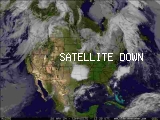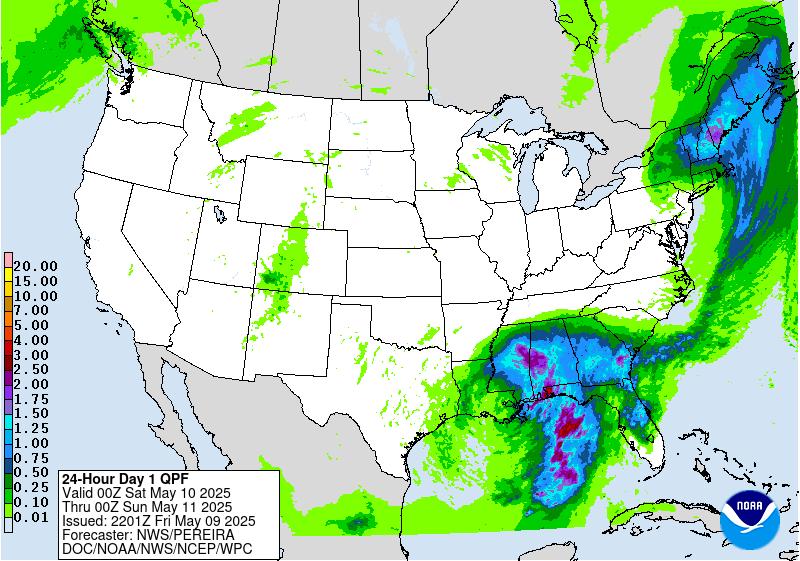SPC AC 181257
Day 1 Convective Outlook
NWS Storm Prediction Center Norman OK
0757 AM CDT Sat May 18 2024
Valid 181300Z - 191200Z
...THERE IS A SLIGHT RISK OF SEVERE THUNDERSTORMS FROM PARTS OF
NORTHERN FLORIDA AND THE FLORIDA PANHANDLE TO PORTIONS OF THE
SOUTHERN ATLANTIC COAST...
...SUMMARY...
The greatest severe-thunderstorm potential today appears to be from
the Florida Panhandle eastward to the southern Atlantic Coast, with
damaging gusts the main concern.
...Synopsis...
Distinct northern- and southern-stream features over nearly opposite
parts of the CONUS will continue to exert the greatest influence on
severe-thunderstorm potential. In the North, a well-developed,
zonal to cyclonic mid/upper-level jet core was evident from the
coastal Northwest to the northern Plains. Some amplification in
that belt is likely overnight, as a shortwave trough digs
southeastward across the Pacific Northwest.
Downstream, a compact but strong shortwave trough -- evident in
moisture-channel imagery over western ND and southeastern SK --
should move east-northeastward to southern MB and northern MN by
00Z, forming a closed 500-mb low over the Lake Winnipeg vicinity.
The attached trough should eject northeastward to northwestern ON by
12Z tomorrow. The associated surface cold front -- drawn at 11Z
over eastern MN to near FSD, EAR, GLD and PUB -- should reach Lake
Superior, northern WI, central IA, and south-central KS by 00Z,
stalling across southwestern KS into eastern CO. By 12Z, the front
should reach northern Lower MI, northern to west-central IL, and
northern MO, while moving northward as a warm front near the I-70
corridor in KS.
Meanwhile, a positively tilted mid/upper-level shortwave trough --
with several associated vorticity maxima -- was evident in
moisture-channel imagery from KY across the Mid-South to
south-central TX. The main vorticity lobe -- now over the
northeastern AR/western TN area -- should shift eastward to middle
TN by 00Z, with trough southwestward to TX shelf waters of the Gulf.
By 12Z, the trough should extend from the western Carolinas across
southern AL. The associated surface low -- analyzed at 11Z near MEM
-- should move eastward today and devolve into a weak trough. An
outflow-reinforced marine front was analyzed over shelf waters off
the middle Texas Coast to just southeast of the Mississippi River
mouth to near PNS, then across southern parts of GA and SC. This
boundary should drift eastward over the north-central Gulf Coast
region and across GA.
...Southeast...
Scattered thunderstorms in clusters -- including occasional/embedded
supercells -- have been persistent this morning just offshore from
the LA/MS/AL coastline to near the western FL Panhandle, reinforcing
the marine/outflow boundary on the southern margins of that
convection. That, and persistent rainfall north of the boundary
across southeastern LA to the AL Gulf Coast, have led to decreasing
unconditional severe potential over those areas.
Instead, the greatest threat today should be with the eastern/inland
extent of the loosely organized Gulf convective plume, which extends
along and north of the boundary over the FL Panhandle and southern
GA. Damaging wind will be the main concern, with a tornado or two
possible, and isolated large hail. This region should continue to
exhibit the greatest low-level moisture/instability through the day
as the convection undergoes a net eastward shift, with surface
dewpoints commonly in the 70s F, areas of cloud-tempered diurnal
heating, weak MLCINH and MLCAPE reaching the 2000-2500 J/kg range.
Deep shear will favor organized convection, with effective-shear
vectors continuing to be commonly in the 40-50-kt range -- albeit
aligned with a substantial component parallel to the main swath of
convective lift. As such, mode should remain somewhat messy,
clustered to linear, with some embedded supercell/bow structures
possible.
Elsewhere, less-organized convection (mainly due to weaker shear)
should occur near the peninsular FL Atlantic Coast, and ahead of the
midlevel vorticity lobe and surface low/trough, from the Mid-South
across the Tennessee Valley. Isolated damaging gusts and marginally
severe hail will be possible.
...Midwest...
Thunderstorms should develop from mid/late afternoon into early
evening along the cold front -- with coverage diminishing from
scattered across the Lake Superior and WI/northeastern IA regions to
widely scattered or isolated from southern IA to portions of KS.
Damaging gusts will be the main concern, though any sustained,
relatively discrete cell may rotate and produce locally large hail
as well.
Development should occur later over the MO/KS segment than farther
north, due to the presence of capping related to an EML. The
strongest flow aloft and deep shear should remain behind the surface
front, with effective-shear magnitudes generally ranging from around
45-50 kt over the MN Arrowhead to less than 30 kt over southeastern
KS. Low/middle-level lapse rates and boundary-layer moisture also
should increase with southward extent, but the opposite will be true
for deep-layer lift/forcing. A narrow corridor of favorable MLCAPE
should develop today ahead of the front, ranging from around 1000
J/kg either side of western Lake Superior to 2000 J/kg over east-
central KS. These offsetting factors and the probable quick
evolution to quasi-linear mode in northern areas -- combined with a
narrow east-west and temporal window for the most vigorous
convection before nocturnal stabilization contribute to weakening --
support keeping unconditional probabilities at marginal levels for
this update.
...Central High Plains...
Widely scattered, high-based, somewhat skeletal thunderstorms are
expected to develop over the mountains and foothills of central/
south-central CO this afternoon near the front, and move
east-northeastward over the adjoining High Plains from late
afternoon into parts of tonight. The main concern will be isolated
strong-severe downbursts. Activity will be supported initially by
diurnal heating of higher terrain, with marginal but adequate
moisture to support convection at those altitudes. While strong
gusts are possible in the mountains, the activity should move atop a
deep, well-mixed subcloud layer over the downshear central High
Plains. That deep boundary layer will be characterized by nearly
dry-adiabatic lapse rates, and enough moisture to support 200-500
J/kg MLCAPE. Eastward extent of the threat is uncertain, but in
general, should diminish overnight as nocturnal stabilizing of the
near-surface profile proceeds.
..Edwards/Goss.. 05/18/2024
CLICK TO GET WUUS01 PTSDY1 PRODUCT
NOTE: THE NEXT DAY 1 OUTLOOK IS SCHEDULED BY 1630Z






















































































